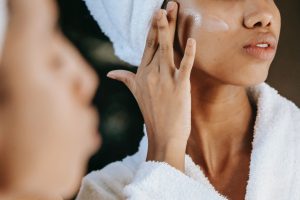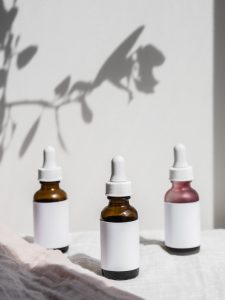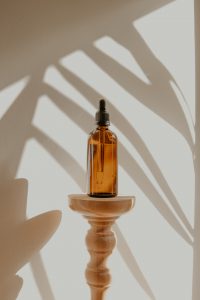Healthy Skin
How to adapt your skincare routine for menopausal skin
Perimenopause and menopause can often throw your skin out of whack. From new acne breakouts to extra dryness, you may see some changes to your complexion during this transition. As a result, it may be time to adapt your skincare routine to suit your menopausal skin.
The good news is, with a few simple tweaks, your skin will be back to its best in no time. We spoke to Dr Sajjad Rajpar, Consultant Dermatologist and Midland Skin Clinic Medical Director, for advice.
How to adapt your skincare routine for menopausal skin
What skin changes are likely during menopause?
 Fluctuating hormone levels that occur through perimenopause and menopause can often result in changes in our skin.
Fluctuating hormone levels that occur through perimenopause and menopause can often result in changes in our skin.
We may experience more dryness than we’re used to, see new acne breakouts or notice that our skin is thinner and has less elasticity due to collagen production slowing down in the body.
It’s also important to remember that changes to the skin can occur all over our body – not just on the face.
“The face is three percent of the body and you’ve got to look after all of your skin – function and appearance,” Sajjad reminds us.
Dryness
As Sajjad explains, dryness is the most common skin change during this period.
“Oestrogen is required for your body’s skin hydration mechanisms,” he says.
“Your own internal moisturisers are increased when you have oestrogen. So that includes things like ceramides, sebum and hyaluronic acid.
“Those three things preserve water in the skin. If you don’t have enough oestrogen then you don’t have as much of those three things, and then you lose water, causing dry skin.”
As a result of dry skin, we may experience itching too.
 So, what can we do? When it comes to cleansing the skin, Sajjad suggests avoiding soaps, which can dry the skin out further.
So, what can we do? When it comes to cleansing the skin, Sajjad suggests avoiding soaps, which can dry the skin out further.
“Soaps remove the grease layer on the skin, which is already weak,” he says. “Anything that lathers or bubbles is going to dry the skin further.
“If someone has got tolerant skin, they could use a hydrating cleanser. If they’ve got very sensitive skin, then they ought to just use a very thin, light moisturiser to wash with – that’s what anyone with inflamed skin would also be treated with by a dermatologist.”
Sajjad says thin moisturisers can be E45, Diprobase cream, Cerave moisturising lotion, and Cetaphil lotion, all of which can be purchased cheaply on the high street.
“The simple thing is, you can wash with that, you can moisturise with them. So you’ve got one product to keep it very simple,” he explains.
Declining collagen
As we age, collagen levels decline in the body, which can result in skin thinning and fine lines appearing. However, using retinoids can help to increase collagen to keep skin looking plumper and smooth.
“Treatments that can increase collagen in the skin are retinoids (so retinoid creams), and then preventing collagen breakdown from sun protection, which is your biggest factor, and avoiding smoking, which is your other biggest factor,” says Sajjad.
Energy-based treatments, such as laser, radio frequency and pixel, can also help to stimulate collagen in the skin. These make small injuries to the skin, which can stimulate new collagen formation.
While these treatments can help, replacing oestrogen with HRT – if you are able and want to – should be the first port of call.
“Your collagen formation is better when you’ve got oestrogen so you’re probably likely to respond better if you’ve got better collagen making mechanisms,” Sajjad says.
“You lose such an amount of collagen in the first five years following menopause, you’re not going to likely build that all back from retinoids and from laser treatments.
“The first port of call has to be, if the woman is eligible, oestrogen to replace what’s missing.”
Supplements can be another option for supporting collagen levels. The Wellbeing team loves Ingenious Beauty. This supplement works from the inside-out to strengthen hair, skin and nails. Use the code LIZLOVES to save 15% off your order.
Acne
Spots are thought to affect around five to 10 percent of of perimenopausal and menopausal women. “Often it’ll be people who had acne as a teenager or with their menstrual cycle in adulthood,” explains Sajjad.
If you are experiencing acne during perimenopause or menopause, there are certain ingredients that you may find helpful.
“Simple things that can help acne are salicylic acid washes, benzoyl peroxide gel, and retinols,” suggests Sajjad. “All three of those things can be obtained without a prescription. Those are your top three anti-acne ingredients.”
Should you adjust your skincare routine during menopause?
 When we experience skin changes, it’s tempting to go all out with skincare, layering on serum after acid after AHA. But, as Sajjad explains, this can actually make matters worse.
When we experience skin changes, it’s tempting to go all out with skincare, layering on serum after acid after AHA. But, as Sajjad explains, this can actually make matters worse.
“That’s an increasing problem, that people are overdoing their skincare,” he says. “Putting too many active ingredients, too many irritant ingredients and then running into skin barrier problems. They end up with additional irritation from having too many products on their skin on the background of an already weakened skin barrier.
“And then people can get much more irritation and flares of what look like rosacea.
“There’s so much information out there that isn’t always logical. People end up following various different regimes simultaneously, and buy and layer many, many products.”
Instead, Sajjad advocates for keeping your facial skincare routine simple. At a very basic level, he suggests including a non-foaming, soap-free cleanser, a moisturiser and SPF.
“I believe in just one product on the skin at any one time rather than multiple layers,” he says.
You don’t need to be in menopause to take his advice on board either, as it applies at any age. One of our favourite SPFs is made by sustainable brand, UpCircle. SPF 25 Mineral Sunscreen is designed for all skin tones and is ultra-hydrating and fast-absorbing.
Key ingredients to use
If your skin can tolerate it, there are a few additional extras you can add into your skincare routine for menopausal skin. Here, Sajjad suggests following the alphabet, with vitamins A, B, C, D and E.
 Vitamin A, also known as retinols (over the counter) and retinoids (what doctors prescribe), helps stimulate collagen production in the skin. However, around 20 percent of people cannot tolerate this ingredient as it can cause a lot of dryness and irritation.
Vitamin A, also known as retinols (over the counter) and retinoids (what doctors prescribe), helps stimulate collagen production in the skin. However, around 20 percent of people cannot tolerate this ingredient as it can cause a lot of dryness and irritation.
“B stands for niacinamide, or vitamin B3 which many, many people will tolerate very easily,” says Sajjad. “It’s reasonably gentle on the skin but helps reduce redness and inflammation. It’s actually helpful for acne as well.
“Vitamin C is a very strong antioxidant and we know that sunlight causes oxidation damage and vitamin C mops that up. It’s been shown to reduce the effects of sun damage and help preserve collagen and reduce pigmentation.
“Vitamin D stands for oral vitamin D because you’re going to be so good with your skin sunscreen that you’re going to be blocking the natural sunlight that would otherwise be stimulating vitamin D in your skin, so you’d take 800 IU a day just to keep that going.
“We know vitamin C works better when you’ve got vitamin E, which is another antioxidant and a substance called ferulic acid – all of them work together better than vitamin C alone.”
One of our favourite vitamin E rich serums is ishga’s Nourishing Face Oil. Rich in nourishing plant oils, it glides onto the skin to help balance the complexion. Use LIZLOVES to save 15% off your order.
How many products to use
While these vitamins are handy ingredients, it doesn’t mean we should be layering on five different serums each day.
“It is possible to put them all-in-one, but what I wouldn’t do is layer,” explains Sajjad. “I wouldn’t buy five different serums with five different ingredients and put one on top of the other. We don’t know how they’re going to react on the skin or how the products interact with one another.
“If you’re super sensitive, you could just pick one of those ingredients out, work with that, and build to an all-in-one serum.”
All-in-one products are also a good option as they’ve been thoroughly tested to check that the formulation is stable.
“All-in-products are really good if you can tolerate more than one ingredient,” says Sajjad. “Try and get them all in one base, so you know that it’s stable, and that you’re not combining things that you don’t know how they’ll react on the skin.”
It’s important to remember that retinol is normally a nighttime treatment, too. Meanwhile, vitamin C can be a morning treatment or a nighttime treatment, but only if you’re not using retinol.
Dr Sajjad developed Potent C Skin Care Serum, which uses vitamins C, B3, B5 and E, plus ferulic and two types of peptides, in a stable, all-in-one formulation.
An important reminder
While it’s important to take care of our skin, Sajjad explains that it’s important to be realistic.
“The problem is skincare is skincare whether you’re menopausal or not. There’s nothing additional other than all these products […] have anti-ageing benefits. But they would have anti-ageing benefits on a man too,” he says.
“The unique thing for a woman is to replace her oestrogen and then go for the ingredients that have been around the longest that have the most evidence.”





